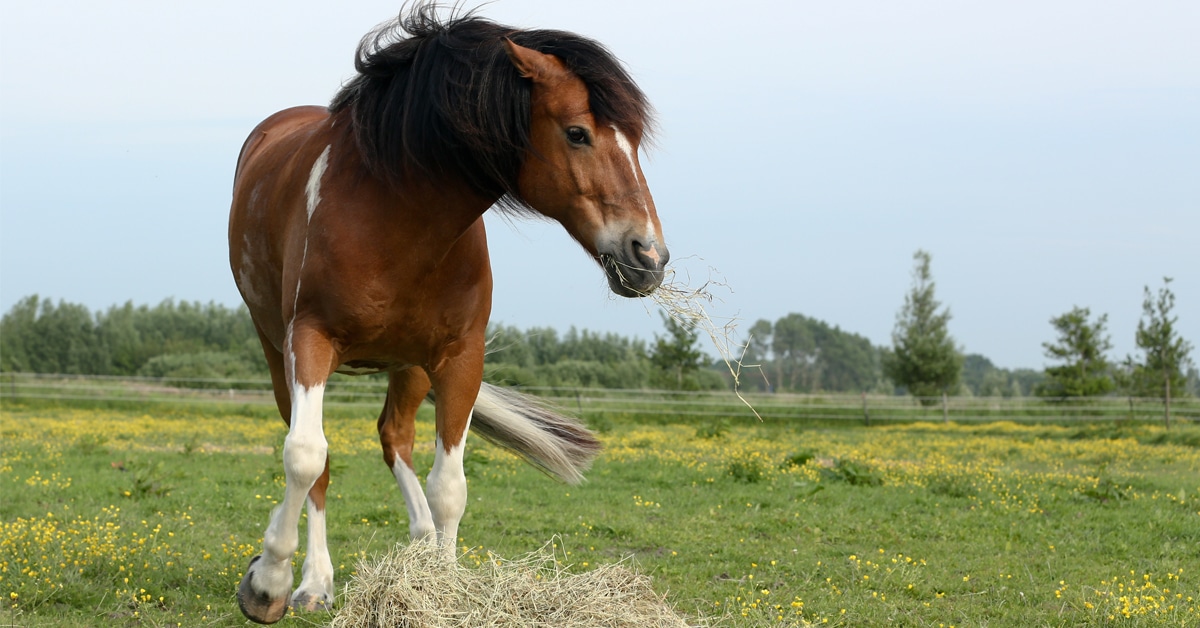Part 1: Identifying equine psychological well-being
Most of us like to think that we recognize when our horses are ‘happy,’ but research suggests that we may not be quite that skilled at discerning equine well-being.
Your horse greets you with a welcoming whinny. Snugged in his stall, cozied up in his puffy blanket, safe from the elements, free from potential bullying stablemates, and blooming with optimum physical health, this is a happy horse! Or is it?
Most of us with any horse savvy feel that we have a solid sense of when our horses are happy, and that we do not need scientific scrutiny to tell us so. However, research suggests that we may not be as skilled at discerning equine well-being as we think. Subtle or non-existent behavioural cues, human desensitization to equine suffering, and ignorance about what well-being looks like all compromise our ability to identify equine happiness. Fortunately, there are objective measures that can provide greater insight into our horses’ psychological well-being. In this first of a two-part series I explore why our own understanding of a horse’s happiness is prone to error, and in Part II, how we might do a better job of measuring equine welfare and thus take steps to improve it.
The Fédération Equestre Internationale (FEI) now includes a preamble to the official rules of each of its disciplines. “The FEI Code of Conduct for the Welfare of the Horse” strives to regulate standards where “the welfare of the horse [is] paramount” and “never subordinated to competitive or commercial influences (2014, p. 8).” Discipline-specific rules aspire to “the horse’s freedom,” the creation of “good pictures” and the “the development of a happy athlete (2014, p. 10).” These are admirable and lofty goals, but what do they mean, and how would we know when we had achieved them?
Why it is hard to identify a “happy” horse
1. The problem of stoicism
Although most of us believe that if our horses are stressed they will tell us, research challenges the notion that we can determine a horse’s distress by behavioural indicators alone. British researchers Kelly Yarnell and Carol Hall looked at behavioural and physiological measures of stress before, during, and after a “sham” clipping – a 10-minute session with clipping blades removed (2013). Based on previous clipping history, horses were grouped as either “compliant” or “non-compliant.” Not surprisingly, non-compliant horses displayed greater reactivity and less relaxed behaviours. However, all the horses (both compliant and non-compliant) exhibited equal physiological indicators of stress: higher cortisol levels, elevated heart rate, and increased eye temperature, even in this abbreviated session. The authors suggest that horses may suppress flight responses when escape is not possible and that this suppression is a known contributor to the development of abnormal behaviours and adverse physiological health.
More subtle behavioural markers of stress may be missed altogether. In an intriguing study by French researchers Rochais and Henry (2016) differing housing conditions impacted horses’ optimism about the possibility of a pleasurable event. Once horses had been trained to remove a lid from a bucket that always contained a tasty food reward, and to ignore a lidded bucket that did not, researchers then placed additional empty lidded buckets between the two. Horses that lived in environmentally enriched conditions (in social groups on pasture) were more optimistic than individually-housed horses and continued to investigate additional buckets in the hopes of hitting a jack-pot. Isolated and pessimistic horses retrieved their treat from the bucket that reliably produced a reward and ceased investigating further. Since our sport horses typically live in these environmentally-impoverished conditions, much of their discontent may be too subtle to notice unless we are really looking for it.
2. Learned helplessness looks like compliance
When horses (like other animals, including humans) face prolonged, inescapable stress, they are vulnerable to “learned helplessness.” This term was originally coined by Martin Seligman (1978) who conditioned dogs to jump over a barrier at the sound of a bell, alerting them that the floor on which they were standing would soon be electrically charged. When Seligman then charged floors on either side of the barrier so that the dogs could not escape the aversive event, they eventually ignored the warning bell, whimpered, and lay down on the charged floor. When the escape route was reintroduced the dogs remained inert, even though physiological measures indicated that they were highly distressed.
Carol Hall and her research group (2008), who studied this state in horses, suggest that learned helplessness is a logical adaptation to inescapable aversive conditions. When a behaviour has no impact on consequences, there ceases to be any motivation to try novel strategies. It becomes maladaptive, however, because it generalizes to other aspects of horses’ behavioural repertoire, and results in negative physiological and psychological manifestations such as ulcers, weight loss, and abnormal behaviours.
Equine scientist Andrew MacLean (2009) notes that what trainers may mistake as submission, obedience, and successful training, may in fact be a horse who has given up trying to escape from relentless conflicting pressure. When the horse’s discipline requires a “flat affect” such as western pleasure horses, show hunters, or “bomb-proof” school horses, a state of learned helplessness is often considered not only normal, but desirable.
3. The New Normal: When distress becomes invisible
We may also overlook obvious behavioural cues because regularly working with stressed horses may desensitize us such that abnormal behaviours become the new normal. Stereotypies such as weaving or cribbing are behaviours that follow an invariant, repetitive sequence, and appear to serve no obvious purpose. They have never been observed in feral horses and are thought to be “the disease of domestication” (Marsden, 2002). Precipitated by intense management practices of confinement, isolation, and diets high in quality but low in quantity, they are almost certainly indicative of compromised welfare.
In a study of 373 horses in 26 riding schools, Lesimple and Hausberger (2014) had caretakers complete questionnaires about the occurrence and rates of specific stereotypies (e.g. cribbing, weaving, flank biting, stall-walking, tongue playing, lip flapping, etc.). Monitoring horses for six hours per day for three consecutive days, trained observers then recorded the occurrence of all stereotypies. Lesimple found large discrepancies between what caretakers believed (5% prevalence of stereotypies) and what the researchers observed (37% prevalence). Furthermore, this discrepancy was evident not only for milder stereotypies such as tongue playing, but also for more obvious and maladaptive stereotypies. Twenty-three percent of the horses were observed weaving, but only 8% were identified by caretakers!
Lesimple notes that caretakers’ consistent underestimation of these poor-welfare indicators may be similar to that found in health-care practitioners who tend to underestimate the severity of patients’ pain (Hirsh et al., 2011), and are less accurate at identifying facial expressions of pain than those without healthcare experience. (Prkachin et al., 2004). As with health care practitioners, Lesimple found that greater exposure exacerbated this effect. The higher the prevalence of stereotypies at a given stable, the less likely caretakers were to see it. In the stable where stereotypies reached 70%, the discrepancy between caretaker reports and objective measurements was the greatest. Presumably, being exposed to large populations of suffering individuals distorts healthcare workers’ and horse caretakers’ perceptions of “normal” behaviours and expressions.
4. The absence of “bad-being” is not “well-being”
Where the presence of stereotypies may be an accurate marker of “bad-being,” it does not mean that other horses in the same environment without stereotypies are not suffering. Stereotypies are thought to be involved in endorphin release and thus provide a buffering effect in an uncontrollable stressful environment. Some researchers have suggested that fellow stablemates who experience the same environment, but without the stereotypic coping mechanisms, may actually be worse off (Henderson, Horse Canada, Sept/Oct. 2014).
As Jones and McGreevy note: “Animal welfare legislation makes it possible to prosecute people who carry out acts that are … cruel to animals, but it does not make it a legal requirement that all animals have good welfare (2010, p. 199).” Whipping race horses is now under scrutiny, as research reveals that whipped horses experience pain, but do not run faster when whipped (McGreevy 2012, 2015). Yet less obvious practices such as restrictively tight crank nosebands in dressage, or weighted and pinch boots in show jumping, can be equally harmful, but tend not to come under the public radar.
We are even less likely to note problematic practices that are commonplace. Much research has demonstrated the negative welfare impact of singly housing horses in stalls and preventing tactile contact with other horses – a practice akin to solitary confinement and equally taxing for horses as it is for people (see Henderson, Horse Sport, April 2011.).
Happy athletes?
Some equine researchers have suggested that calling competition horses “athletes” – happy or otherwise – is in itself problematic, as it implies that the horse can be a willing participant in the drive, desire, effort, and self-sacrifice that goes into the elusive and particularly human psychological goal of winning (McLean & McGreevy, 2010; see also Henderson, Horse Sport, December 2012). They suggest that governing bodies such as the FEI might be better off to highlight instead what is tangible and measureable. In next month’s follow-up, I will explore how we might strive for the development of the happy equine athlete, and objectively know when we have attained these goals.
Modern management practices of confinement and isolation almost always lead to compromised psychological well-being.
Moral Disengagement: When good people do bad things
Humans, for the most part, engage in practices that meet our moral standards and keep us feeling good about ourselves. However, according to psychologist Albert Bandura, our standards may be overridden by psychological devices that foster moral disengagement. Through a gradual severance of self-censure we are able to tolerate increasingly uncomfortable acts of harm, often without awareness that our ethical line in the sand has shifted. Our high moral standards as a benevolent horse person remains intact even as we cause our horses to suffer.
• Cognitive remodeling: We compare ourselves to others whose treatment is worse, or use sanitizing language that makes harmful conduct respectable (“We had a bit of a conversation about that,” meaning that the horse was hit, spurred, and/or yanked repeatedly to punish an undesired behaviour).
• Cognitive distortion: We diffuse responsibility onto others such as coaches, or minimize or deny the harmfulness of the practice (“We only use bamboo poles for rapping. It doesn’t actually hurt him.”).
• Distortion of consequences: We minimize, ignore, distort, or disbelieve the harm we cause, making self-censure unnecessary. Many of the harmful effects of housing horses in solitary confinement are easily discredited, particularly since the negative impact is not always obvious.
• Empathic decay: We blame the horse, reasoning that he if does not perform the desired behaviour it is justifiable to punish him.
Bandura notes that this cognitive restructuring of investing harmful behaviour with high moral purpose is a spectacularly powerful mechanism for disengaging moral control. It not only eliminates self-censure, but serves to validate immoral behaviour. In this way we distance ourselves from our horse’s suffering, pursue our competitive goals with a clear conscience, and feel validated for doing so.
Through a gradual severance of self-censure we are able to tolerate increasingly uncomfortable acts of harm, often without awareness that our ethical line in the sand has shifted.
The Latest









